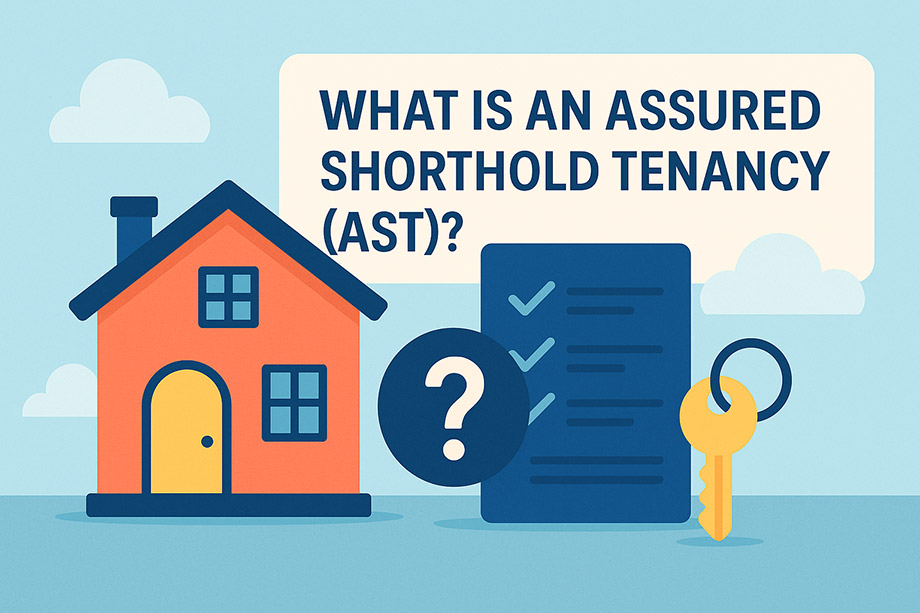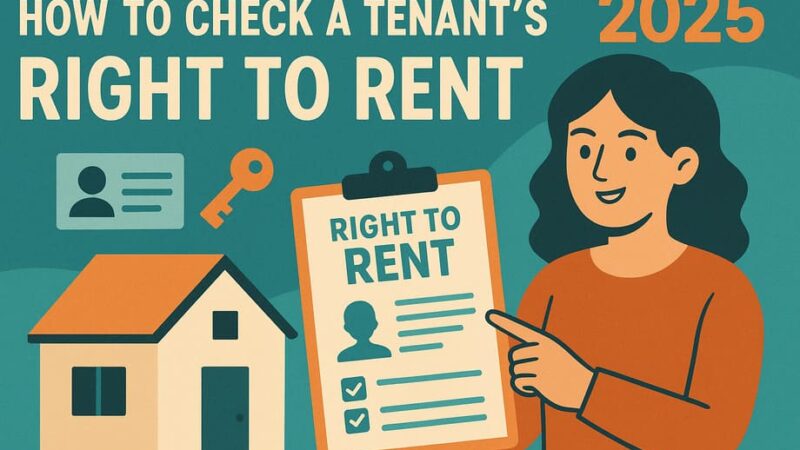What is an Assured Shorthold Tenancy (AST)?

An Assured Shorthold Tenancy (AST) is the standard rental agreement covering approximately 95% of private rental properties in England. However, major changes are coming in 2025-2026 when the Renters’ Rights Bill becomes law, abolishing Section 21 “no-fault” evictions and converting all ASTs to periodic tenancies.
If you’re renting or planning to rent a property in the UK, understanding your tenancy agreement is crucial. Whether you’re a tenant wanting to know your rights or a landlord preparing for upcoming changes, this comprehensive guide will walk you through everything you need to know about Assured Shorthold Tenancies in 2025.
What Is an Assured Shorthold Tenancy?
An AST agreement exists to protect both you, as the tenant, and the landlord and sets out the terms for you to live in the landlord’s property. It is normally a written agreement (but can be verbal) that clearly outlines your responsibility for the condition of the property and the responsibilities of the landlord whilst you are their tenant.
An Assured Shorthold Tenancy (AST) is the most common form of tenancy agreement in England and Wales, covering approximately 95% of all private rental properties. Introduced by the Housing Act 1988 and reformed by the Housing Act 1996, ASTs provide the legal framework that governs the relationship between private landlords and tenants.
Think of an AST as the legal rulebook for your rental relationship. It defines what you can expect from your landlord, what they can expect from you, and provides protection for both parties throughout your tenancy.
How Do You Know If You Have an AST?
These are the requirements for a letting arrangement to be an Assured Shorthold Tenancy in England: The tenancy started on or after 15 January 1989.
Your tenancy is likely an AST if:
- The tenancy began after 15 January 1989
- You rent from a private landlord (not the council or housing association)
- The property is your main home
- Your landlord doesn’t live in the same property
- You pay rent to live there
All qualifying tenancies created after 28 February 1997 are automatically ASTs unless specifically created as assured tenancies
Key Components of an AST Agreement
A written AST will state the terms of your tenancy agreement:
- Start date and end of the fixed-term
- Rent to pay
- Date rent must be paid
- Address of the rented property
- Name and address of all parties (e.g. tenant, landlord and letting agent)
- When and how the rent is reviewed
- Deposit amount and the scheme which protects it
- When the deposit can be withheld
- Bills the tenant is responsible for
Essential Information Every AST Should Include:
Property Details
- Full address of the rental property
- Description of what’s included (furnished/unfurnished)
- Any shared areas or facilities
Financial Terms
- Monthly or weekly rent amount
- Payment dates and methods
- Deposit amount and protection scheme details
- Which bills and services are included or excluded
Tenancy Duration
- Fixed-term length (typically 6-12 months)
- Start and end dates
- Notice periods for ending the tenancy
Parties Involved
- Full names and addresses of all tenants
- Landlord’s name and address
- Letting agent details (if applicable)
- Emergency contact information
Types of AST: Fixed-Term vs Periodic
Fixed-Term Tenancies
Most ASTs start with a fixed term tenancy, commonly six or twelve months. After this, if no new contract is signed, it often becomes a periodic tenancy, which rolls on a weekly or monthly basis depending on how rent is paid.
Characteristics of fixed-term ASTs:
- Guaranteed security for the agreed period
- Rent typically cannot be increased during the fixed term
- Both parties are committed for the full duration
- Early termination usually requires a break clause
Periodic Tenancies
After your fixed term ends, your tenancy typically becomes periodic unless you sign a new agreement. If you stay without signing a new agreement, your tenancy becomes periodic. This means it rolls on monthly at the same rent.
Characteristics of periodic ASTs:
- No set end date – continues until properly terminated
- Rent can be increased with proper notice (usually annually)
- More flexibility for both parties to end the tenancy
- Notice periods apply (typically 1 month for tenants, 2 months for landlords)
Common Clauses in AST Agreements
Understanding the typical clauses in your AST helps you know what’s expected and what’s negotiable:
Rent Review Clauses
Landlords can review the amount of rent you pay when the ‘fixed term’ ends and increase it if they have a good reason for doing so, e.g. in line with the Retail Price Index (RPI) or property/rent price increases in the local area. A rent review clause in your AST will confirm this.
Pet Policies
Whether or not you can rent with a pet will be defined in the AST. Landlords who permit pets can not request a higher deposit or a professional cleaning service (at the end of the tenancy) but they can charge a higher rent. The higher rent charge must be made clear to you before signing the AST.
Subletting Restrictions
Look out for any clause on subletting if you plan to sublet the property. You must get permission from the landlord to sublet the property and there could be a clause prohibiting you from doing so.
Property Alterations
You may wish to hang pictures or take down fixtures or fittings that aren’t to your taste, but doing so may breach the terms of your AST. Landlords can include clauses which state that you are not allowed to alter the property in any way or put holes in the walls (for picture frames or shelves) without their permission.
Garden and Maintenance Responsibilities
There is often a clause for gardens and shared areas requesting that they be kept in reasonable condition, such as cutting the grass, trimming hedges or ensuring no excess rubbish builds up. You can’t be expected to do any more than the average person and if you don’t have the tools to maintain a garden, check whether any are supplied by the landlord.
Smoking Policies
The AST will likely include a clause stating that you are not allowed to smoke inside the property. You should seek clarification as to where you are permitted to smoke around the property.
Tenant Rights Under ASTs
Your Right to a Written Agreement
You can ask for a written statement of terms. This means: Your landlord must give you a written statement of terms if you ask for it. You also have the right to the name and address of your landlord.
Protection from Illegal Clauses
Just because a clause exists in your AST does not necessarily mean it’s enforceable by your landlord or letting agent. For example, any fees that are now illegal under the Tenant Fees Act cannot be enforced, even if you have signed the agreement. The law always takes precedence over anything in your agreement, written or otherwise.
Disability Accommodations
The agreement must not discriminate against you if you are disabled and the landlord should adapt the tenancy to suit your needs. You can also make requests to the landlord and seek their written consent, such consent is ‘not to be unreasonably withheld’. This means that the landlord must grant permission unless they have a valid reason not to.
Current Tenant Rights Include:
- Quiet enjoyment of your home without unnecessary interference
- 24-hour notice before landlord visits (except emergencies)
- Safe and habitable property meeting health and safety standards
- Protected deposit in a government-approved scheme
- Challenge excessive rent increases through tribunals
- Protection from retaliatory eviction in certain circumstances
Landlord Responsibilities Under ASTs
The AST should state what the landlord is legally responsible for, as well as any additional responsibilities they may choose to take regarding the property. These will include giving you at least 24 hours’ notice before a visit occurs, ensuring the property is compliant with all health and safety regulations, describing what parts of the property they will repair or replace and any other legal obligations they have.
Key Landlord Obligations:
Safety Requirements
- Landlords by law must test the smoke and/or carbon monoxide detector on the first day of the tenancy
- Annual gas safety certificates
- Electrical safety inspections every 5 years
- Energy Performance Certificate (EPC)
Property Standards
- Landlords must ensure the property meets safety standards and is fit for habitation, including gas safety, electrical safety, and structural integrity
- Repairs to the structure and exterior
- Heating and water systems maintenance
- Common area upkeep (in shared properties)
Administrative Duties
- Deposits must be protected in approved schemes, with clear information about how to reclaim deposits at the tenancy end
- Providing required documentation (How to Rent guide, gas certificates, EPC)
- Right to rent checks
- Registering with local authorities where required
How to End an AST
For Tenants
During Fixed Term:
- Check for break clauses in your agreement
- If you want to leave the tenancy early, there may be a ‘Break Clause’ that will allow you to leave (free of charge) up to a defined date. The AST will also outline the notice period you must give.
- May be liable for costs if leaving without a break clause
During Periodic Tenancy:
- The tenant can then terminate the tenancy by serving one month’s notice
- Must give proper written notice
- Notice period typically aligns with rent payment frequency
For Landlords
Currently Available Options:
Section 21 (No-Fault Eviction)
- Currently requires 2 months’ notice
- No reason needed if properly served
- Cannot be used during fixed term (unless break clause exists)
- Being abolished in 2025-2026
Section 8 (Fault-Based Eviction)
- Requires specific grounds (rent arrears, breach of tenancy, etc.)
- Notice periods vary by ground
- Requires court proceedings
- Will become the primary eviction method after reforms
Major Changes Coming: The Renters’ Rights Bill 2025
Timeline and Implementation
The commencement date of the Bill – in other words, when it comes into effect – will likely be in early 2026. While the Government is keen to implement the abolition of Section 21 and ASTs as soon as possible, other parts of the Bill won’t take effect immediately.
This means it’s highly likely that Angela Rayner will be able to go to the Labour Party conference and say they have enacted the abolition of Section 21 with the Renters’ Rights Act 2025 (even if it won’t come into force until later).
Key Changes for ASTs
1. Abolition of Section 21 Abolish section 21 evictions and move to a simpler tenancy structure where all assured tenancies are periodic – providing more security for tenants and empowering them to challenge poor practice and unfair rent increases without fear of eviction.
2. End of Fixed-Term ASTs The Renters’ Rights Bill will convert all fixed-term assured shorthold tenancies (ASTs) to periodic tenancies overnight. Any fixed-term tenancies you sign now will be affected by this when the Bill becomes effective.
3. New Tenancy Structure The Renters’ Rights Bill will remove fixed-term assured tenancies. Fixed-term tenancies mean renters are obliged to pay rent regardless of whether a property is up-to-standard, and they reduce flexibility to move in response to changing circumstances, for example after relationship breakdown, to take up a new job or when buying a first home. Instead, all tenancies will be periodic, with tenants able to stay in their home until they decide to end the tenancy by giving 2 months’ notice.
What This Means for Current and Future Tenancies
For Existing ASTs:
- On this date the new tenancy system will apply to all private tenancies – existing tenancies will convert to the new system, and any new tenancies signed on or after this date will also be governed by the new rules. Existing fixed terms will be converted to periodic tenancies, and landlords will no longer be able to serve new section 21 or old-style section 8 notices to evict their tenants.
For New Tenancies:
- All new tenancies will be periodic from the start
- No more fixed-term commitments
- Greater flexibility for tenants to move
- Landlords will rely on Section 8 grounds for possession
Enhanced Tenant Protections
Rent Increase Limitations Landlords can increase rent using Section 13 notices, giving at least one month’s notice for monthly tenancies, with increases limited to once per year. Rent increases must be reasonable and in line with local market rates. Tenants can challenge excessive increases through the First-tier Tribunal.
Improved Property Standards A critical goal of the Bill is to improve housing quality in the private rented sector. To achieve this, the Decent Homes Standard, which already applies to social housing, will be extended to the private rented sector.
New Ombudsman Service Landlords will be required to join a new Private Rented Sector Landlord Ombudsman Service to help resolve disputes.
What Should You Do Now?
For Current Tenants
Immediate Actions:
- Review your current AST carefully
- Understand your current rights and obligations
- Keep a safe copy of your agreement
- Document any property issues or repair needs
Preparing for Changes:
- Stay informed about the Renters’ Rights Bill progress
- Consider how periodic tenancies might affect your housing plans
- Understand that you’ll have greater security once changes take effect
For Landlords
Before the Changes:
- Review all existing AST agreements
- Ensure full compliance with current requirements
- Consider your long-term letting strategy
- Improve property standards to meet Decent Homes Standard
Preparing for Reforms:
- Familiarize yourself with new Section 8 grounds
- Review rent review processes
- Consider joining professional landlord organizations
- Prepare for ombudsman registration requirements
For Prospective Tenants and Landlords
If Signing ASTs in 2025:
- Understand that fixed terms will become periodic when reforms take effect
- In other words, a three-year tenancy signed in December 2025 would instantly become periodic if the Renters’ Rights Bill became effective in February 2026, replacing the fixed term.
- Consider how this affects your housing or investment plans
Common AST Problems and Solutions
Deposit Disputes
Disagreements over deposit deductions for cleaning, damage, or unpaid rent. Most common area of tenant-landlord conflict.
Solutions:
- Document property condition at start and end of tenancy
- Understand what constitutes fair wear and tear
- Use deposit protection scheme resolution services
- Keep receipts for professional cleaning or repairs
Rent Increase Disputes
Current Position:
- Landlords can only increase rent annually
- Increases must be reasonable and market-related
- Tenants can challenge through tribunals
After Reforms:
- Same limitations will apply
- Enhanced protection against retaliatory increases
- Stronger tenant rights to challenge
Repair and Maintenance Issues
Know Your Rights:
- Landlords must maintain property structure and systems
- Report issues promptly in writing
- Keep records of all communications
- Use local authority enforcement if necessary
Looking Ahead: The Future of Private Renting
The Renters’ Rights Bill represents the most significant change to private renting in over 30 years. According to the government, this change will protect approximately 11 million tenants from arbitrary eviction.
What Success Looks Like
For Tenants:
- Greater security and stability in their homes
- Protection from retaliatory evictions
- Improved property standards
- Fairer rent increase processes
For Landlords:
- Clearer, more standardized regulations
- Professional tenants who stay longer
- Better dispute resolution mechanisms
- Level playing field with professional standards
Preparing for Transition
The government has committed to providing “sufficient notice” before implementation, likely giving the sector at least 6 months to prepare after Royal Assent. This transition period will be crucial for:
- Updating tenancy agreements and processes
- Training letting agents and landlords
- Establishing new ombudsman services
- Implementing the Private Rented Sector Database
Key Takeaways
Understanding ASTs Today:
- ASTs are the foundation of most private rental relationships in England
- They provide important protections for both tenants and landlords
- Written agreements offer the best protection for all parties
- Know your rights and responsibilities under current law
Preparing for Tomorrow:
- Major changes are coming that will benefit tenants significantly
- Section 21 “no-fault” evictions will be abolished
- All tenancies will become periodic, offering greater flexibility
- Property standards will be enhanced across the sector
Taking Action: Whether you’re a tenant or landlord, staying informed and prepared is essential. The upcoming changes represent an opportunity to create a fairer, more stable rental market that works better for everyone.
The key to navigating both current ASTs and future changes is understanding your rights, meeting your obligations, and maintaining open, honest communication between all parties. With proper preparation and knowledge, the transition to the new system can benefit everyone involved in the private rental sector.
Remember: While this guide provides comprehensive information about ASTs, always seek professional legal advice for specific situations or disputes. The rental market is complex, and individual circumstances can significantly affect your rights and obligations.
Last Updated on August 1, 2025 by James Cartwright







